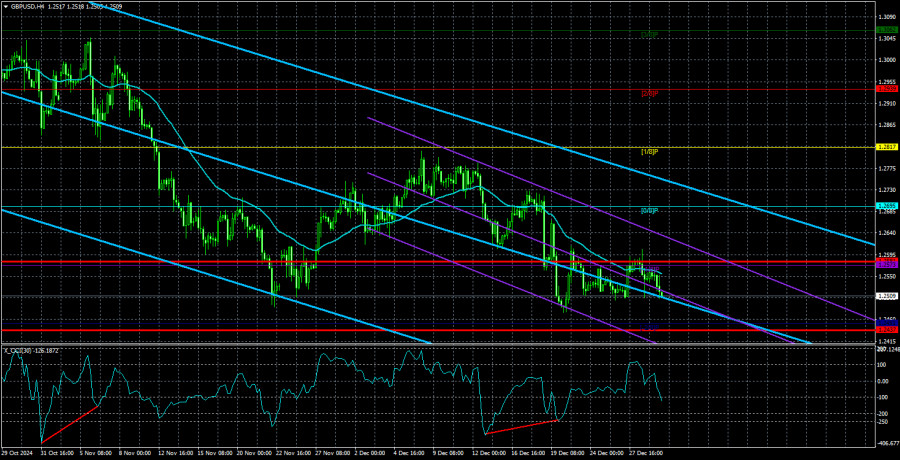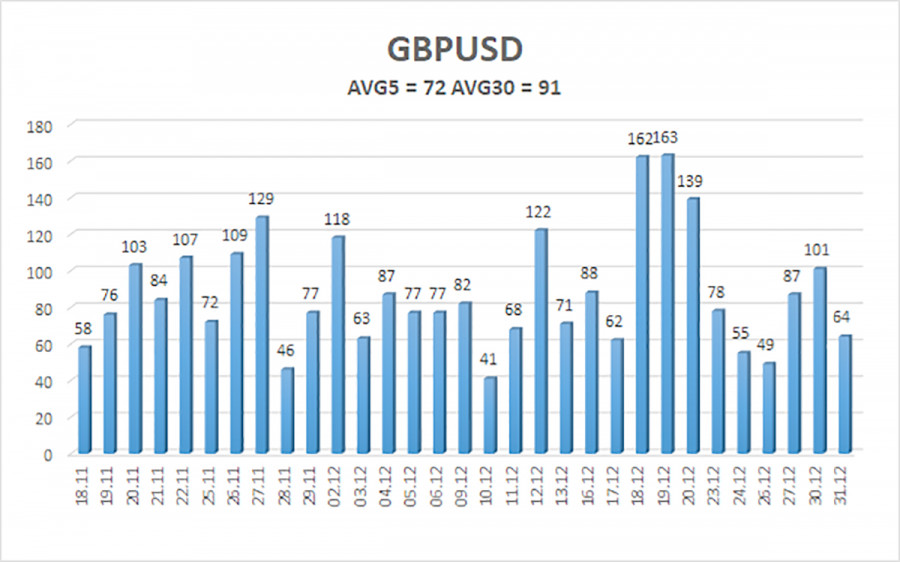See also


 02.01.2025 08:31 AM
02.01.2025 08:31 AMOn Tuesday, the GBP/USD currency pair continued its downward trend without any local macroeconomic or fundamental justification. The economic calendar has been empty for two weeks. After reaching the $1.2500 level, the pound sterling (like the euro) corrected slightly upward, only to return to the $1.25 mark. Thus, recent movements for both currency pairs have been almost identical. If this trend continues, the pound sterling is likely to keep falling. The reasons remain the same—global factors. Downward trends persist across all higher timeframes.
The market sold the dollar for two years due to the Federal Reserve's easing monetary policy. However, this factor has already been priced in, whereas the Bank of England is only beginning to ease its policy. The UK economy remains in decline, and Donald Trump's presidency threatens further slowdown. Meanwhile, the U.S. economy remains robust, with the Fed expected to cut rates only twice in 2025—far fewer than the market had anticipated since autumn 2022.
Thus, there seems to be no reason for the bears to halt their momentum. On the weekly timeframe (which should be the primary focus), it's clear that the price has been correcting for two years against a more significant downward trend that has lasted 16 years. Consequently, until this trend is officially reversed (which could take years), the expectation should be further declines in the pound sterling. While a return to parity with the U.S. dollar seems unlikely, it cannot be entirely ruled out. We consider $1.1800 as the first realistic target. The pound is unlikely to reach this level before January 20, but the fundamental situation may shift after that date. Nevertheless, this target is entirely achievable in 2025.
The average volatility of the GBP/USD pair over the last five trading days is 72 pips, which is considered "moderate" for this pair. On Thursday, January 2, we expect the pair to trade within the range of 1.2437 to 1.2581. The higher linear regression channel points downward, indicating a continued bearish trend. The CCI indicator recently dipped into the oversold zone again, signaling a potential correction. However, as we've repeatedly warned, any oversold signals within a bearish trend only indicate temporary corrections. A bullish divergence on the CCI also suggests a correction, which may now be complete.
Support Levels:
Resistance Levels:
The GBP/USD currency pair maintains its downward trend. The 1.2500 level could be breached soon. We still do not consider long positions viable, as we believe all factors supporting the British currency's growth have already been priced in by the market multiple times, with no new drivers present. Suppose you trade based on "pure" technicals, long positions may be considered with a target of 1.2695 if the price exceeds the moving average line. However, long positions are currently much less relevant than short ones. Sell orders can be considered with targets of 1.2451 and 1.2437.
Linear Regression Channels help determine the current trend. If both channels are aligned, it indicates a strong trend.
Moving Average Line (settings: 20,0, smoothed) defines the short-term trend and indicates the direction in which trading should align.
Murray Levels represent target levels for movements and corrections.
Volatility Levels (red lines) indicate the probable price channel the pair is likely to trade over the next day based on current volatility metrics.
CCI Indicator: If it enters the oversold area (below -250) or overbought area (above +250), it signals a potential trend reversal in the opposite direction.
You have already liked this post today
*The market analysis posted here is meant to increase your awareness, but not to give instructions to make a trade.
Trading on the last day of the week is unfolding positively. News that China is ready to begin negotiations has inspired investors to buy risk assets and weakened the U.S
Only a few macroeconomic events are scheduled for Friday, but some are quite significant. Naturally, the focus is on the U.S. NonFarm Payrolls and unemployment rate, yet it's also important
On Thursday, the GBP/USD currency pair continued to decline. The dollar had strengthened for three consecutive days—despite having no objective reason. U.S. macroeconomic data has been consistently weak; there were
On Thursday, the EUR/USD currency pair once again traded relatively calmly, but the U.S. dollar failed to show any meaningful growth this time. A little bit of good news goes
InstaTrade video
analytics
Daily analytical reviews

Your IP address shows that you are currently located in the USA. If you are a resident of the United States, you are prohibited from using the services of InstaFintech Group including online trading, online transfers, deposit/withdrawal of funds, etc.
If you think you are seeing this message by mistake and your location is not the US, kindly proceed to the website. Otherwise, you must leave the website in order to comply with government restrictions.
Why does your IP address show your location as the USA?
Please confirm whether you are a US resident or not by clicking the relevant button below. If you choose the wrong option, being a US resident, you will not be able to open an account with InstaTrade anyway.
We are sorry for any inconvenience caused by this message.


